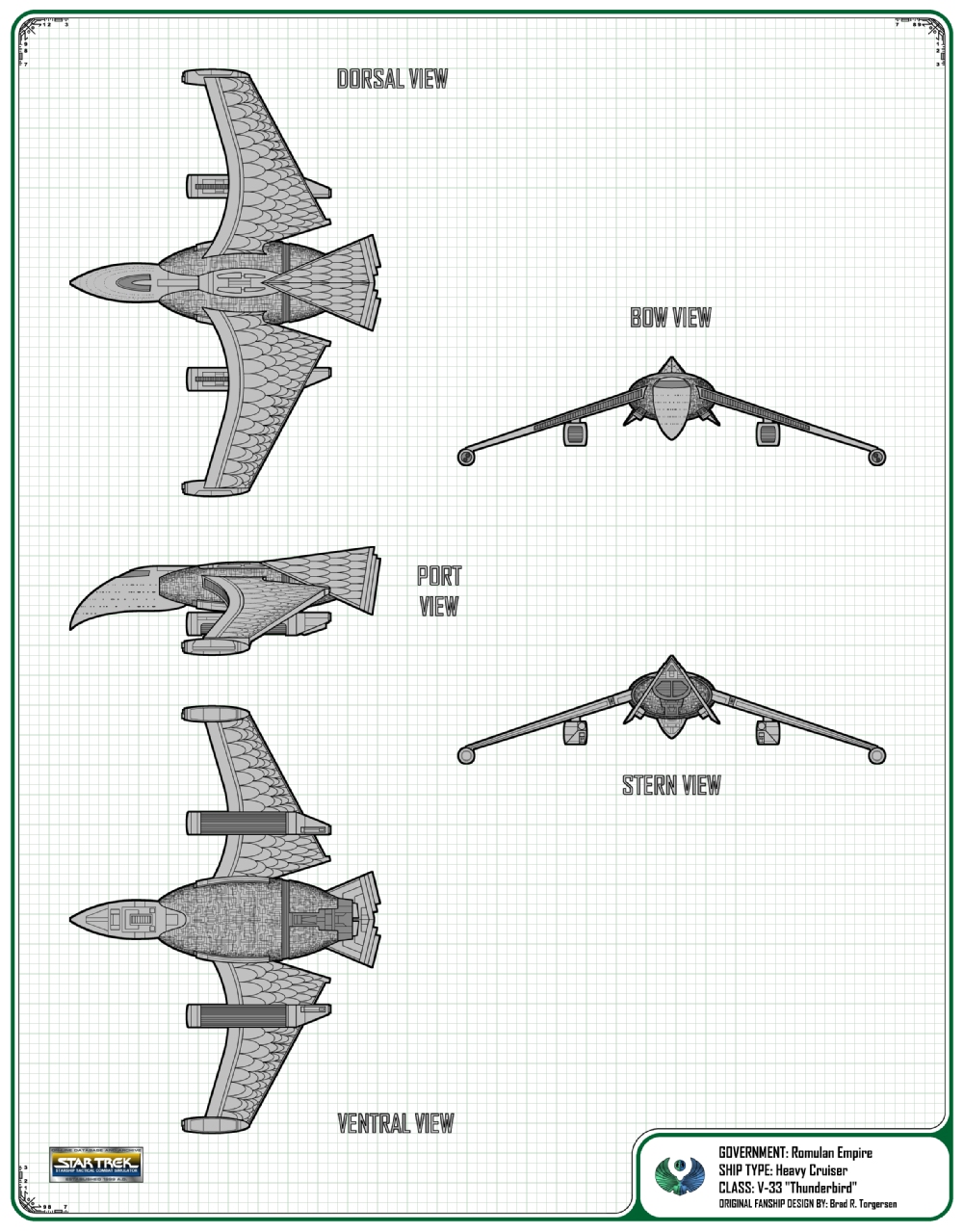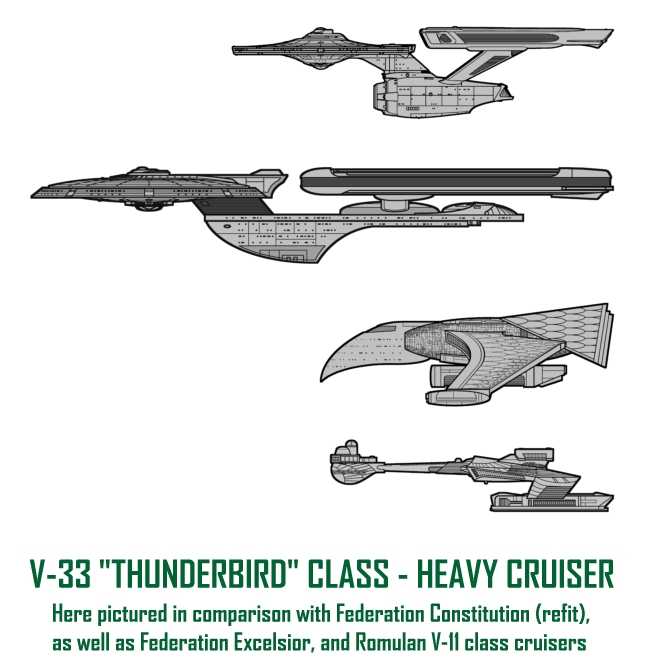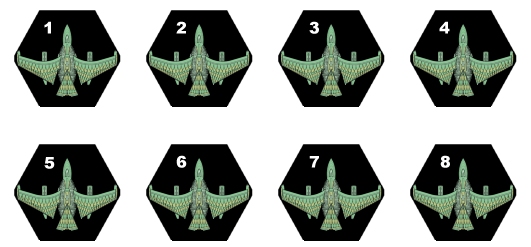![]()
V-33 "Thunderbird" Class ● Heavy Cruiser ● Romulan Empire

CLICK ABOVE TO SEE A DOUBLE-SIZE BLUEPRINT
|
THIS IS AN OLDER, RATHER DATED FANSHIP DESIGN I PUT TOGETHER BACK IN 1992, for a campaign with my highschool best friend, Kris Long. Given the developments in the Star Trek universe since 1992, much of the backstory I wrote for this class seems a little silly. Obviously I was trying to make the V-33 fit into the FASA conception of the Star Trek universe, and one wonders how there could continue to be Romulan incursions into Federation territory when an early TNG episode makes it clear that the Romulans break off contact with the Federation not long after the events of Star Trek VI. Still, I put a lot of work into this design back in '92 and after debating at length whether to include this class in the OLD&A, I said to myself, what the Hell. I've also added a Type 3, Type 4, and Type 5 so as to give this ship some longevity and fighting power against more modern ships. As this class is a contemporary of the Excelsior, I wanted it to have a useful lifespan about as long as that class, with similar battle numbers. Art-wise, this was one of the last fanships I ever drew by hand, borrowing much from the bird aesthetic which typified both FASA and canon Romulan design. — BRT
FANSHIP
DESIGN & STATS: Brad R. Torgersen, 1992 |

| Construction Data: Model Numbers- Ship Class- Date Entering Service- Number Constructed |
Type 1 XI 2/2200 39 |
Type 2 XI 2/2211 11 |
Type 3 XII ? ? |
Type 4 XII ? ? |
Type 5 XII ? ? |
| Hull Data: Superstructure Points- Damage Chart- Size Length- Width- Height- Weight- Cargo Cargo Units- Cargo Capacity- Landing Capability- |
32 C 233.8 meters 322 meters 81.5 meters 210,000 tons 450 units 22,500 tons none |
35 C 233.8 meters 322 meters 81.5 meters 210,000 tons 450 units 22,500 tons none |
41 C 233.8 meters 322 meters 81.5 meters 235,000 tons 450 units 22,500 tons none |
50 C 233.8 meters 322 meters 81.5 meters 246,000 tons 450 units 22,500 tons none |
55 C 233.8 meters 322 meters 81.5 meters 247,000 tons 450 units 22,500 tons none |
| Equipment Data: Control Computer Type- Transporters- Standard 9-person- Emergency 20-person- cargo- Cloaking Device Type- Power Requirement- |
R6M-1 4 2 1 RCE 38 |
R6M-1 4 2 1 RCE 38 |
RSCX-A 6 4 4 RCE 38 |
RSCX-B 6 4 4 RCE 38 |
RSCX-B 6 4 4 RCEX-3 48 |
| Other Data: Crew- Troops- Passengers- Shuttlecraft- |
410 none 10 4 |
410 none 10 4 |
400 none 20 6 |
390 none 30 7 |
390 none 30 7 |
| Engines and Power Data: Total Power Units Available- Movement Point Ratio- Warp Core Type- Power Units Available- Stress Charts- Maximum Safe Cruising Speed- Emergency Speed- Impulse Engine Type- Power Units Available- |
68 4/1 RWG-1 48 G/L Warp 7 Warp 9 RIE-3 20 |
68 4/1 RWG-1 48 G/L Warp 7 Warp 9 RIE-3 20 |
89 4/1 RTWC-5 66 M/K Warp 7 Warp 9 RIF-VII 23 |
105 4/1 RTWC-7 82 K/F Warp 7 Warp 9 RIF-VII 23 |
121 5/1 RTWC-8 90 K/F Warp 7 Warp 9 RIF-X 31 |
| Weapons and Firing Data: Beam Weapon Type- Number- Firing Arcs- Firing Chart- Maximum Power- Damage Modifiers +3 +2 +1 Missile Weapon Type- Number- Firing Arcs- Firing Chart- Power to Arm- Damage- Plasma Weapon Type- Number- Firing Arcs- Firing Chart- Power to Arm- Damage- |
RB-11 6 in 3 banks 2f/p, 2f/s, 2a V 9 (1 - 10) (11 - 16) (17 - 21) RP-3 6 in three bays 4f, 1a/p, 1a/s Q 1 10 |
RB-11 6 in 3 banks 2f/p, 2f/s, 2a V 9 (1 - 10) (11 - 16) (17 - 21) RPL-2 3 in two banks 2f, 1a M 15 (see chart) |
RD-19 8 in 3 banks 3f/p, 3f/s, 2a U 14 (1 - 7) (8 - 14) (15 - 20) RPL-2 4 in two banks 3f, 1a M 15 (see chart) |
RD-19 8 in 3 banks 3f/p, 3f/s, 2a U 14 (1 - 7) (8 - 14) (15 - 20) RTA-E 3 in three bays 1f/p, 1f/s, 1a N 1 20 RPL-2 4 in two banks 3f, 1a M 15 (see chart) |
RD-21 9 in 3 banks 3f/p, 3f/s, 3a V 16 (1 - 8) (9 - 15) (16 - 21) RTA-E 7 in three bays 3f/p, 3f/s, 1a N 1 20 |
| Shields Data: Deflector Shield Type- Shield Point Ratio- Maximum Shield Power- |
RSO 1/3 15 |
RSO 1/3 15 |
RSM-5 1/1 18 |
RSM-6 1/3 21 |
RSM-7 1/3 24 |
| Defense Factor- Weapon Damage Factor- |
135.8 121.2 |
140.1 121.2 |
unknown unknown |
unknown unknown |
unknown unknown |

CLICK HEX GAME PIECES TO VIEW AND PRINT SEPARATELY